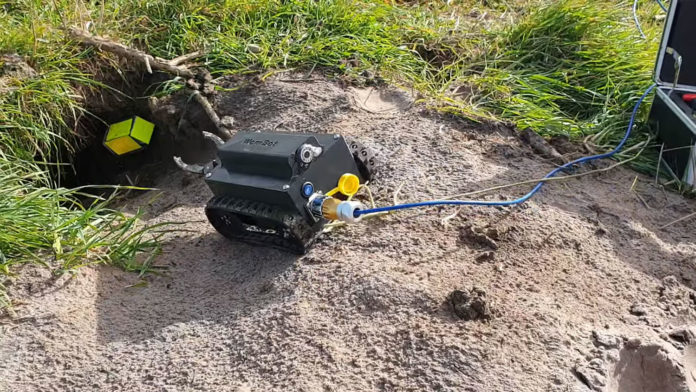Wombats are primarily nocturnal animals that reside and sleep in burrows and occupy a different burrow every four to ten days. Parasitic Sarcoptes scabies mites, which cause sarcoptic mange, a serious disease affecting wombats, are thought to be transmitted when wombats occupy each other’s burrows, but it has not been clear whether conditions within burrows promote this transmission.
Now, engineers from La Trobe University and the University of Tasmania, Australia, have developed WomBot, an exploratory robot that can be used to explore and study environmental conditions within wombat burrows. The purpose-built robot traverses through the difficult terrain present in wombat burrows whilst facilitating placement and retrieval of environmental data loggers.
WomBot is remotely operated and moves using continuous tracks, similar to a tank tread, at a top speed of 0.15 meters per second (0.5 km/h). The battery-powered device is 30 cm long, weighs 2 kg, and is able to climb inclines of up to 22 degrees. It is also equipped with environmental sensors that can measure the temperature and humidity of a burrow, while a gripper attached to its front can be used to place and retrieve additional environmental sensors. Also, for ease of navigation inside the hole, the developers installed two wide-angle cameras with LED lights on the robot – in front and rear.
“Wombat burrows are challenging to study as they are narrow, muddy, can be dozens of meters long, and contain steep sections and sharp turns,” says Robert Ross, the corresponding author of a paper on the study. “WomBot allows us to enter and explore these burrows without destroying them or using expensive ground-penetrating radar. This can help us better understand the environmental conditions within burrows that may facilitate sarcoptic mange transmission.”
In September 2020, the engineers used WomBot to explore a total of 30 wombat burrows in Tasmania. They found that the average temperature inside the burrows was 15 degrees Celsius, and the average relative humidity was 85%. Environmental sensors left in the burrows over a 24 hour period recorded that temperatures remained mostly constant at 11 degrees Celsius, and relative humidity ranged from 85 to 95%.
Researchers estimate those female mites could survive for between nine and ten days at the entrance to a wombat burrow and between 16 and 18 days inside a burrow, potentially allowing them to infect wombats.
“Our findings indicate that the environmental conditions within wombat burrows may facilitate sarcoptic mange transmission by promoting mite survival. WomBot could potentially be used to help reduce the spread of sarcoptic mange by delivering insecticide or ensuring burrows are empty before being temporarily heated in order to eradicate mites,” said Robert Ross.
